#I used so many refs to try to make them look accurate to their cultures without just using stereotypes but I’m sure I made mistakes
Explore tagged Tumblr posts
Text

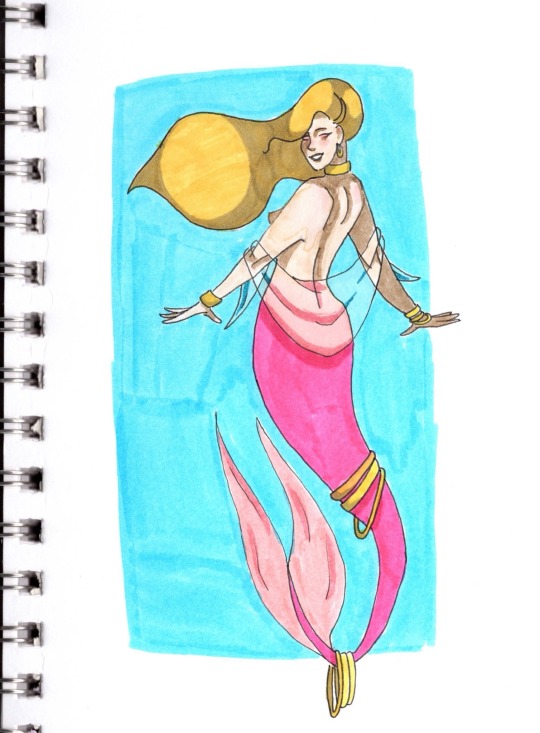


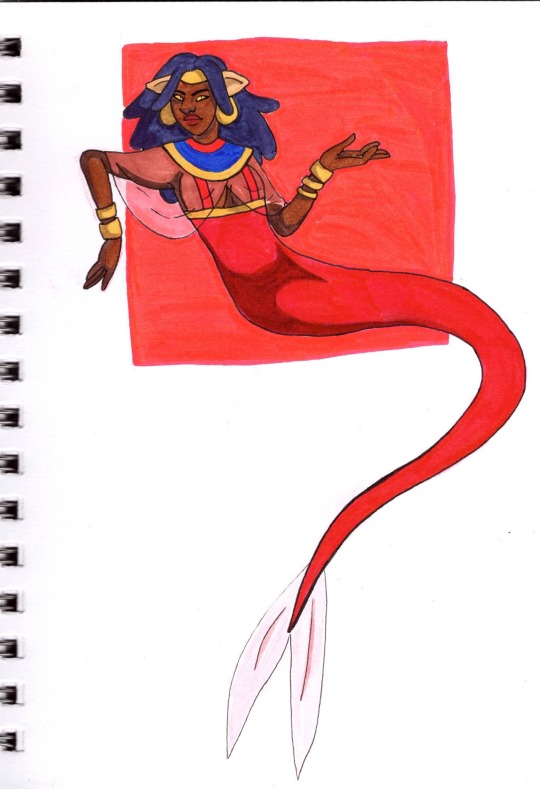
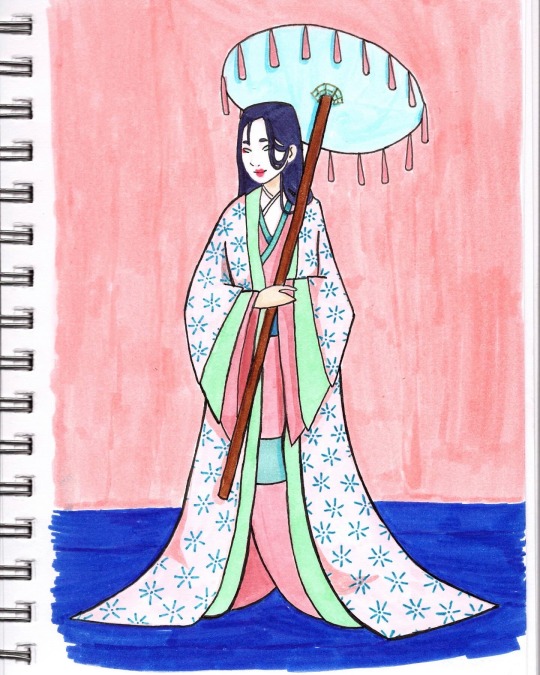
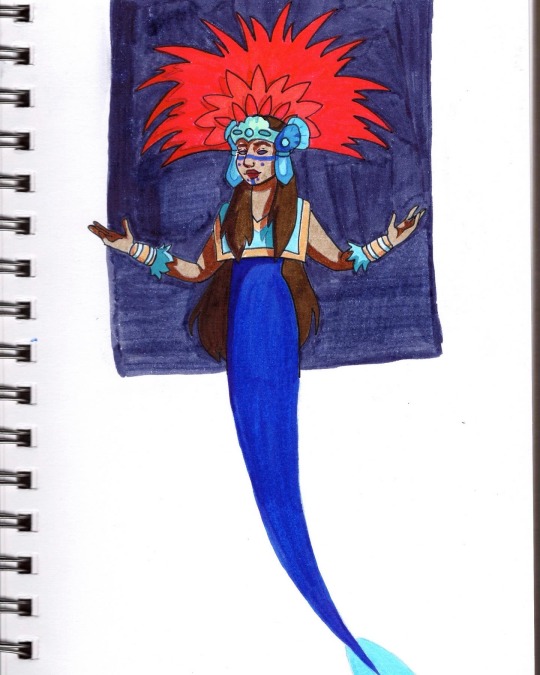

Did a mermay challenge on insta and thought I would post it here
#I used so many refs to try to make them look accurate to their cultures without just using stereotypes but I’m sure I made mistakes#if anything is culturally insensitive PLEASE tell me so I can fix it/learn better#I had a week to do any sort of research so it’s obv very surface level#mermay#tagamemnon#ancientsirens#medusa#aphrodite#mazu#ran#tefnut#suijin#citlallicue#greek mythology#chinese mythology#norse mythology#egyptian mythology#japanese mythology#aztec mythology#my art#myart#traditionalart#I used a mix of different types of markers but mostly tombow water based#tombow markers
11 notes
·
View notes
Text
How to Fix Ilvermorny
Issue:
One School for ALL of America??
Fix:
A seperate school for each state. (more detail under the cut, i've put too much thought into this)
Ilvermorny STARTED OUT as a single school is Massachusetts, founded by Morigan and her family. At the time (1620) this was perfectly fine. “America” was still just the 13 colonies. Which is still pretty large and could have likely used a few more schools to manage well, I imagine a witch from Ireland wouldn't have really thought of that. Especially since she canonically didn't intend to found a wizarding school from the get-go. She was just trying to teach her sons. Other little wizards and witches slowly made their way there, and she decided to try her hand at teaching them too, and the school grew from there.
Now, as America grew in size and population… One school ain’t gonna cut it for long. I’m sure we’ve all seen the maps that compare the size of the UK to the size of the US. (If you haven't, look it up, its pretty funny. Texas alone is bigger than the whole country.) The expansion didn’t happen overnight, but i imagine at some point the Ilvermorny staff would have had an “oh fuck” moment, having way too many students and way too little space, and they needed a solution FAST.
My solution? Ilvermorny School of Magic is one school, technically. One curriculum, one main campus, one overarching school leadership. However, every state (other than Massechusets, which is where the main campus is located) has it’s own satellite school or branch campus. Idk which term is more accurate. Essentially, every american wizard goes to Ilvermorny. It’s just “Ilvermorny of Pennsylvania,” “Ilvermorny of Texas,” “Ilvermorny of Washington,” etc etc. All of these schools function basically the same with only a few minor differences based on the cultures of where their from. They all have the same four houses, mostly the same structure, the same general curriculum and content.
This solution also allows for worldbuilding that would further differentiate American wizarding society from British wizarding society (because i’ve always felt a little iffy on how it kinda seemed like the US corner of the wizarding world was just a british author being like “haha look at the americans trying to copy us cause we’re cooler,” yknow?)
FOR EXAMPLE
Quidditch is still a big thing here, yeah? I think thats a pretty agreed upon fandom thing. (I’m also playing around with maybe we gave it a different name, to mirror the “soccer/football” divide lol, but for now lets call it Quidditch for ease.) Every state school has it’s own Quidditch team, and rather than playing against the other houses, you play against the other schools. Which means… y’all know how the South treats college football?
Yeah. When Quidditch season starts, we are invested. We are locked in. Oh, your kid made the school Quidditch team? You’re bragging about that shit. You’re traveling to all the games. I don't care if their playing in Alaska, you’re going. Your kid didn't make the team? Doesn't matter! You’re still so fucking invested. Signs in the front yard, foam fingers, jerseys, posters, bitching about how the ref must have been blind because how in the world did Ilvermorny Illinois beat Ilvermorny Georgia? There are rivalries, too, and they are INTENSE. And they 100% mirror the state rivalries that already exist in muggle US culture. (And yes, i’m using muggle instead of no-maj. Cause no-maj sounds dumb as hell.)
ALSO
The size and prestige of each Ilvermorny campus depends solely on the population (and general wealth) of the state that they are in. California has a gigantic school that is practically it’s own fucking town at this point. Rhode Island, on the other hand? They pretty much only have their own school for principles sake, they could probably have been looped into Ilvermorny Connecticut or Ilvermory Massechusettes without causing too much of a problem. But if every other state gets their own, Rhode Island kind of has to as well. This also means theres totally conversations that happen when you meet someone from another Ilvermorny that’s just comparing campuses. Like you’re telling me you had Three whole quidditch pitches?! And how many students per graduating class?? Jesus. (Think the conversation you have between small town kids and big city kids.)
(There was also definitely some fucked-up complications when segregation and “separate but equal” happened, but i dont want to get into the politics of it all, that’s a whole different post that someone with more knowledge can make.)
Anyways, that’s my two cents. I have more ideas, more issues with Ilvermorny that i want to find ways to fix and flesh out, but this post in long enough already.
#harry potter#ilvermorny#harry potter meta#american wizarding world#wizarding world#wizarding society#ilvermorny school of magic#harry potter fandom#harry potter headcanon#long post
38 notes
·
View notes
Note
I'm trying to put together a Jiangshi Mei and I'm having a hard time of where to begin.. Any tips or suggestions for me? //Thank you so much for this blog!
Hello there!
This is going to be a generic response to “how do I begin on a cosplay” type questions. Normally I don’t answer these, but this allows for a guide that other cosplayers can follow.
The first thing I would do is take a look at the slides for my Planning Your Cosplay panel, which was developed to answer this exact question. It should, at the very least, give you a starting point.
The next step is to start researching! This can be time-intensive even if you generally know what you are looking for, but even more so if you don’t, so here’s a few pointers. Often, research and costume breakdowns (as described both in the panel linked above and in the section below) go hand-in-hand, since you may need to research what something is before you can come up with any sort of plan for it.
- Get your references in order. If the costume is from a live-action property, you may get lucky and find information from the costumers or from other fans who have seen the costumes in person (or spent the hours watching the series or movie so you don’t have to). If the costume is from a video game, see if models of the character have been released or ripped. Some game companies also put out cosplay guides these days with breakdowns in them! If the costume is from a 2D animated property, see if character reference sheets have been released. These should show all angles of the character in order to keep the artists on model as they draw.
- Look for tutorials or WIPs posted by other cosplayers of the same outfit. This doesn’t always exist, but you may get lucky and see someone else’s breakdown of the outfit, how they made specific pieces, or if you get extra lucky, you might find a tutorial or other instruction on how to make specific pieces. Don’t count on finding this, but it’s a good thing to just see if it exists.
- Use other cosplayers as a guide. This doesn’t mean that you should copy everything they did, but rather to look and see what others cosplayers did and whether it works for you or not. What fabrics did they use? What other materials? How does it appear to wear? How did they interpret tricky bits of the design? Seeing how others turned something from an image into real life may spark some inspiration, and can give you ideas on what works (and doesn’t) in real life.
- Determine who this character is. What culture are they from? Era? If their garments are inspired by historical and cultural garments, looking up information about how to make garments of that culture and era can help you gain pattern and tutorials for those garments. It helps to first find out the name of the garment if it is something you are unfamiliar with, and then look for how-tos from there. You may not end up making something entirely culturally accurate, since it’s a cosplay, but it can get you much closer to modify the types of garments that the costume design is based on. If the setting is purely fictional, is it based on any particular culture and era? For example, many fantasy series are loosely based on medieval Europe, and looking at clothing from that culture can help you figure out what you are looking at and how to make it, even if it will almost certainly require modifications.
- Once you have determined who the character is, you can use that for more editorial decisions about the costume as well. What fabrics would this character wear? Would it be mostly natural or synthetic fibers, or does it not matter? Is the outfit more formal or casual? What textures would make the most sense? How can you make the colors and textures cohesive in real life? What kind of weathering and other details would this costume have? Much of this will be determined by the nature of the costume itself (such as requiring a stretch fabric for a bodysuit), but you will always have at least some leeway to make these decisions.
- Once you have your breakdown done, how are you going to make each piece? Are you doing sewing with fabrics? Armor? How are you going to attach pieces together? What is the order of the layers of the costume? How are you going to finish items on the surface (such as painting vs. using vinyl on armor pieces)? Even if you have some ideas, I would recommend combing through as many tutorials as you can get your hands on for more ideas on construction methods, especially on specialty sewing techniques you may not find in commercial patterns or sewing books and on cosplay-specific crafting methods like armor.
- Combing through the sections for what you are making on our master tutorial list, as well as doing research on your own on the google, can give you many ideas on how to go about construction. Choose a method that fits your skill level, time budget, money budget, and the effect you want for the costume. You can place any level of importance you want on those individual categories, and even take into consideration other things, such as comfort. Even if you don’t know the specifics of what you want to do and are just looking through, say, the armor section or the horns section generally, you can apply the principles of those tutorials to the specific costume you are making, and even combine techniques if you find something that seems like it would work.
- If you find a tutorial or advice on a technique but it’s not for the specific outfit you are doing, keep in mind that shapes and colors can always be changed to adapt to what you need.
While you are doing your research, it helps to also be simultaneously working on a breakdown. This is a listing of everything in the costume that you will need, and can range from very basic to very complex. This will help you to know what you are looking at when you are looking at a complex costume, will help break down the costume into manageable pieces, and will give you a starting place to work from.
- Get your references in order. Clear images that show are angles are best, but not always possible to find, depending on the design (I’ve personally done a lot of weird old JRPG cosplay where there is only one image of the outfit…). If there are multiple conflicting references, combine them for the effect you like best, or choose one and stick with it. If you are to be competing with the costume, be sure to include all references and explain your rationale for choosing from one ref or another.
- Start labeling each part of the costume. It can help to print out a physical copy of a full body shot or character reference sheet so that you can label each piece of the costume and sketch out parts that may be unclear or that you want to fully understand how they work. You can also sketch out things like the layering of parts of how pieces attach to each other, or any modifications you are making or parts you have to make up (such as if there is no back shot of the outfit).
- I like to make an Excel spreadsheet that lists each material I need, how much I need, and the estimated cost, since it helps to see each material clearly laid out and helps with budgeting. Some people prefer to use an app like Cosplanner. Do your breakdowns however fit you best.
- Start with the most general and move into more specific. For example, first label “skirt” and “blouse,” and then go into more specific things such as “circle skirt” or “knife pleated skirt,” and then even more specific, such as listing out potential materials, tutorials you might use, patterns you might use, etc. This is why a lot of your research and breakdown work will happen simultaneously!
- Figure out material choices, as discussed above. If you are stuck on materials, look at the backs of pattern envelopes for similar garment types and see what they suggest. I also recommend simply going to a fabric store and looking at and touching fabrics (and taking flash photos) in order to find materials that have the properties you need. Does the material on the reference look thick or thin? Does it drape stiffly or fluidly? Does it have any particular shine to it, and if so, what is the quality of that shine? Does the fabric need to stretch in order to encapsulate the body?
- While choosing materials, also keep in mind things like who the character is/the the world they come from, your skill level, your budget, and your personal comfort. If you are going to be wearing something covering in a warm climate, for example, be sure to choose natural fibers so the costume breathes.
- Start gathering things like tutorials and patterns. If you don’t know where to start on sewing something, look at the shapes of the garment compared to real-life garments, including what other cosplayers have done. Look at sewing patterns and see what types of garments are similar to the garments you are trying to make, and start thinking about how to modify the shapes into what you need. If you are doing historical costuming, do the same, only with historical or culturally-specific garments. If doing armor, see how others have patterned armor in similar shapes.
- Start figuring out how to make things! Once you know what everything is in the costume and you have some ideas of techniques, you can start deciding on techniques to use. You may find it helpful to create a document that you write out your breakdown in (so listing out each piece) and then creating a written description of the item, adding reference images, and compiling links to tutorials. This way, you can always go back and reference this document later when you are working on the costume, ensuring that you don’t lose any of your important references or tutorials. If you are competing, you have the added bonus of being able to adapt this document into one where you record what you ended up doing to present to the judges.
This may seem like a lot of steps, and it is, but once you gain experience with cosplay, a lot of this becomes quick decisions that you can make based on your experience. It can be very helpful to look at something as overwhelming as an entire character design and break it down into smaller, manageable components, especially if you are just starting out on your cosplay crafting journey and don’t know where to begin. By following a step-by-step road map such as this, you can get over that initial hurdle and start making!
I hope that helps! Good luck :]
—Fabrickind / Q&A Staff / Twitter
#sheepysol#cosplay 101#beginner's guide#beginner cosplay#cosplay planning#cosplay help#getting started#planning#cosplay#asks#fabrickindfridays
598 notes
·
View notes
Text
I know you probably didn't intend for me to reply to this but I will anyway because why not. This turned into half a novel but I hope you'll read it anyway, maybe even change your mind.
The reason you don't recognise these common tone indicators is... that you don't use tone indicators! I'm in many discords with a lot of neurodivergent ppl, a good portion of which is younger than me (because they're fandom based servers). We use tone indicators all the time and nobody bats an eye at them and if someone does indeed not know what one means... we ask. We literally just ask. It's that easy. Since tone indicators are usually used in real time chats, it really isn't that big a deal.
And if you truly are so socially anxious that you cannot ask the person you are already talking to a question (no offense if you are, we're all different) you can just look it up. "tone indicators list" brings up many results, I've linked one here to make it even easier, (although I do think that one should be updated slightly as, at the time of writing this, it does not have the increaingly popular "/ref" (indicating that something is a reference, eg to pop culture, one of my most used) nor does it have "/gq") and you can also search up the tone indicator without the slash in combination with the words "tone indicator" which will almost always yield an accurate answer within the first three results.
It's a bit like with anything but especially internet slang: the more you use it, the more familiar with it you get. You probably know what the (also frequently used by me) shortenings "ppl", "bc/cuz" or even "v" mean, right? You probably also know what "PS5", "USA" or "km" mean. That's because you've been in contact with them a lot. The same would eventually become true for tone indicators.
As to address two points from your tags: 1) sequences of letters can have more than one meaning (remember the "animal crossing did not attack air conditioners" post?) so even if you originally think "gq" stands for genderqueer, it can still stand for something else as a tone indicator and 2) there are actually multiple reasons you might use shorthand instead of writing everything out, including less time you have to spend typing and a shorter overall message resulting in better readability - plus, having it be short makes it more clear it's a tone indicator, not an alternative to something, since it follows a slash.
All of this "debate" reminds me a lot of when vine captions (and later video descriptions in general, image descriptions, etc) became more commonly used, btw. Like, a minority of disabled ppl is saying "hey, I actually really benefit from having this, could you provide it?" and many other people are coming in with "well I don't need it and also it's annoying" so there's a debate on whether you should provide said accomodation or not. And I hope that, like with captions before it, we eventually settle on providing it because I've had enough emotional turmoil due to not being able to read "tones" to last me a lifetime. (In fact I think we should even start using something akin to tone indicators irl but let's cross that bridge when we're done with this one.)
Finally, for your ultimate convenience, here are the meanings of the five tone indicators I mentioned in my original tags:
/s - sarcasm (or irony, since those are usually treated as synonymous in English). not to be confused with /srs (serious tone)
/j - joking tone or joke
/lh - light hearted tone
/gq - genuine question
/nm - not mad
(speaking of, this entire reply is nm. i genuinely am trying to explain, maybe even change your mind)
In conclusion, language evolves, things have multiple meanings and some people need accomodations. Thank you for your time 💜
PLEASE reblog for a bigger sample size! I know everyone says this, but my blog gets very little interaction, so any reblog helps!
8K notes
·
View notes
Note
so Kagura dresses like a dancer and Hakudoshi wears his 'suikan' like a noble. but i've never heard anything about what Kanna wears. the inuyasha wiki claims that both she and Shunran wear kimono but I'd like to know more if that's possible. sorry if you've already answered something like this before, but I can't even figure out how to work some of the websites in the research guide...
Thank you for actually checking out our Research Guide before asking (a lot of people don’t think to)! Sorry to hear you couldn’t find the answer that way on your own; let’s see what we can do to help...First, let’s get this out of the way: it’s technically never inaccurate to refer to traditional Japanese-type clothing like Kanna’s as “kimono” since it’s still a term used for it today. However, that’s very general - literally, the word originally meant just “thing to wear” (mono was “thing”, ki is one way of saying “wear”)...so in other words, my hand to god, at the time the story is set, it just meant “clothing”. Congratulations Kanna, you are wearing clothing! :DAh...not helpful? No, not helpful.All kidding aside, it’s true that the term as it’s used today is a little more specific, but it’s not by much: these days, even in post-Meiji era Japan, "kimono” refers to specifically “ethnically Japanese” i.e. traditional Japanese clothing (the more general term in the modern era for “clothing” in Japanese is apparently 被服, which we would romanize as hifuku)... but, that is still unhelpful because yes, we can see it’s “Japanese” clothing, but seeing as “Japanese clothing” refers to a REALLY broad swath of clothing ranging from furisode to yukata, suikan etc - it’s incredibly non-specific. In other words, almost as bad as calling both pants and skirts “hakama”; accurate, but not helpful in the least! :PSo. What IS she wearing?Well, I...am sorry to break it to you but I’m not entirely sure yet, anon. >_>Since I’m prepping for Hurricane Irma as I respond to this, I’m unfortunately unable to do that much poking around, but I will say I immediately noticed something interesting about it after looking up reference pictures, one of which was this screencap from the anime adaptation (which is I believe from "Kagura's Dance and Kanna's Mirror", from Season 2, in which Kanna first appears):

Actually, let’s summarize what I’m noticing here, which helps me tell you what it is definitely NOT, and hypothetically might be (or...I thought it might be, more on that in a moment):1.) Looking at the ends of the sleeves near the wrist I can tell her garment is NOT any kind of furisode (literally “swinging sleeve”) type kimono, which have long sleeves that hang down (Sesshomaru’s top, for comparison, is a furisode).2.) Her sleeves are more like those found on the kimono type called a kosode (literally “small sleeves”). They are meant to not get in the way, in other words (Sango wears a kosode when she’s not just wearing her armor by itself, for another comparison; you can see the end of the sleeve near the wrist is of similar design).
3.) SLITS IN THE SHOULDERS.I’m going to have to add some visual ref here to point out why this jumped out at me as a detail.This is a “standard” looking kosode:
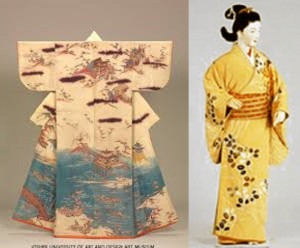
(image pulled from this nifty overview of the evolution of kimono! I recommend giving it a read, it’s very informative!)Now. Pay attention to the shoulders. Scroll back up, and compare - again, there are slits in Kanna’s kimono’s shoulders, but not in “standard” kosode designs.
Slits in that position on the shoulders aren’t at all unheard of in traditional Japanese clothing - they’re found in the suikan type garment that Inuyasha and Hakudoshi both wear, for instance, which as we’ve mentioned before, is designed for as a “hunting jacket” type garment, making me think that that’s why this garment of hers also has them? - but it’s not always a standard feature.(It’s also a feature in Kikyo’s outfit by the way:

Kikyo is an archer, so it makes sense she’d enjoy the fuller movement that those slits provide! Why does Kanna need it though if she relies on her soul-sucking mirror as her “weapon”? Hm. Good question!)Oh -and one more thing. Which I almost missed but which kicks it out of just “kosode” into “okay no, this is a fair freaking question, what IS this??”Look at this other screenshot from the anime I ran across when trying to see “what her obi looked like”:
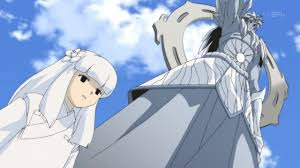
What in the....there’s. Wait. No. That - can’t be.....?*googles more screenshots, confirms*

THERE’S NO OBI.NONE. AT ALL. WHATThere’s no belt?? Where’s the ties?? Is this even a real old-school kimono style or at this point is Takahashi kind of just making it up because “hey it’s a youkai anyway so whatever”? Is it tucked up in there?? How is this even staying in place...? (There’s also those little bows to consider, granted - but I feel like most of those are probably decorative? - but it’s hard to tell, without knowing what the garment even is! Maybe they’re not! Schrodinger’s bows)Okay, Anon. Yes. I see now why you sent this in. I SEE it. I never looked closely at her outfit before and now that I have, I am so far baffled. o_O All in all, I’m not sure exactly what is up with Kanna’s outfit - not 100%. But I do find it interesting (and probably notable!) that it has slits in sleeves, and that it’s clearly not held in place with a normal old-fashioned obi, as we think of one at least. It’s possible (just spit-balling here, especially with Hakudoshi “wearing his suikan like a noble”, and Naraku’s having taken over a noblemen’s place!) that it’s a REALLY old-fashioned noble class children’s outfit? Maybe? That might be a good avenue for research (and I probably would have tried it, were I not prepping for a major hurricane this weekend, sorry anon! ^^;;). I wouldn’t even be surprised if it would be old-fashioned even by Sengoku era standards, mind - we know Takahashi included a by-then-“old-fashioned” suikan for Inuyasha (and Hakudoshi) and put Inuyasha’s very much human mother in a junihitoe (the latter is more like from the Heian period, MUCH earlier), so you never know. Keep it in mind!I will say this though:The more I think about it, the more I find it extremely interesting, too, that the ENTIRE outfit - outer garment, undergarment (which she does have; you can see it under her collar, peeking out through the sleeve-slits, and if you saw a full-body shot that showed her feet, peaking out from under the bottom of her outer garment as well)... the bows on the outfit... even her very hair, and even the decorations in her hair! - All, ALL of them, are solid, pure, non-patterned white.Why do I find this so striking?Because of the various nuanced implications of that in Japanese culture (warning: this link includes a picture of a Japanese corpse being prepped for burial. It’s actually not gross looking at all, but you may find it spooky or unsettling when you realize what it is, so I feel a need to warn ahead of time).Now, despite what the warning in parentheses for that link might seem to imply, and despite what some rumors may say, “death” isn’t the only association with white (and especially white clothing) in Japanese culture; it’s associated with “purity” and cleanliness as well. People aren’t just buried in white, they’re often married in it, too, and many priests and priestesses in Shinto and Buddhism include white clothing in their garb, especially for specific rituals requiring “purity”.I also will clarify that that is NOT a funerary kimono, in the sense that she’s wearing it folded the normal way, and not the opposite way, which corpses are dressed in, so let’s clear that up right away, that she’s not dressed “like a corpse”. At all. But.Still...This feels like it can’t be coincidental...? It’s hard to tell if the white theme is a sign of her “blankness”/emptiness (which is another fair possibility), or if it’s indeed meant to evoke those other WELL known elements in Japanese spiritual beliefs (and it’s still noteworthy I think that to the Japanese, it IS still common to see ghosts wearing solid white, because they are still buried in white, so there’s the subconscious “creepy factor” too, sure)...hn. It’s a real question!I am starting to doubt that it was purely for aesthetics or to save on ink though :P So basically the short answer is: I am real sorry anon, I have no idea. :( I wish I did!The long answer, clearly, is: “WAIT, THIS RAISES EVEN MORE QUESTIONS...??”-Mod VorpalGirl(PS: I probably will not be online the rest of this weekend, at least on here. Seriously, Irma is making her cranky way right up my home State and we decided not to evacuate sooooo. Not only do we need to prep like heck tomorrow, power will likely go out for us before Monday, and given what happened with Hurricane Matthew last year, that could keep me away from ya’ll for up to a week or so. >_> Wish me luck....and Tekka too, since she’s still likely in the path of it as well)
22 notes
·
View notes
Text
TAKE IT FROM THE PROS
1. Focus
“It’s been said that leadership is making important but unpopular decisions. That’s certainly a partial truth, but I think it underscores the importance of focus. To be a good leader, you cannot major in minor things, and you must be less distracted than your competition. To get the few critical things done, you must develop incredible selective ignorance. Otherwise, the trivial will drown you.”
—Tim Ferriss, bestselling author, host of The Tim Ferriss Show
2. Confidence
“A leader instills confidence and ‘followership’ by having a clear vision, showing empathy and being a strong coach. As a female leader, to be recognized I feel I have to show up with swagger and assertiveness, yet always try to maintain my Southern upbringing, which underscores kindness and generosity. The two work well together in gaining respect.”
—Barri Rafferty, CEO, Ketchum North America
3. Transparency
“I’ve never bought into the concept of ‘wearing the mask.’ As a leader, the only way I know how to engender trust and buy-in from my team and with my colleagues is to be 100 percent authentically me—open, sometimes flawed, but always passionate about our work. It has allowed me the freedom to be fully present and consistent. They know what they’re getting at all times. No surprises.”
—Keri Potts, senior director of public relations, ESPN
4. Integrity
“Our employees are a direct reflection of the values we embody as leaders. If we’re playing from a reactive and obsolete playbook of needing to be right instead of doing what’s right, then we limit the full potential of our business and lose quality talent. If you focus on becoming authentic in all your interactions, that will rub off on your business and your culture, and the rest takes care of itself.”
—Gunnar Lovelace, co-CEO and cofounder, Thrive Market
5. Inspiration
“People always say I’m a self-made man. But there is no such thing. Leaders aren’t self-made; they are driven. I arrived in America with no money or any belongings besides my gym bag, but I can’t say I came with nothing: Others gave me great inspiration and fantastic advice, and I was fueled by my beliefs and an internal drive and passion. That’s why I’m always willing to offer motivation—to friends or strangers on Reddit. I know the power of inspiration, and if someone can stand on my shoulders to achieve greatness, I’m more than willing to help them up.”
—Arnold Schwarzenegger, former governor of California
6. Passion
“You must love what you do. In order to be truly successful at something, you must obsess over it and let it consume you. No matter how successful your business might become, you are never satisfied and constantly push to do something bigger, better and greater. You lead by example not because you feel like it’s what you should do, but because it is your way of life.”
—Joe Perez, cofounder, Tastemade
7. Innovation
“In any system with finite resources and infinite expansion of population—like your business, or like all of humanity—innovation is essential for not only success but also survival. The innovators are our leaders. You cannot separate the two. Whether it is by thought, technology or organization, innovation is our only hope to solve our challenges.”
—Aubrey Marcus, founder, Onnit
8. Patience
“Patience is really courage that’s meant to test your commitment to your cause. The path to great things is always tough, but the best leaders understand when to abandon the cause and when to stay the course. If your vision is bold enough, there will be hundreds of reasons why it ‘can’t be done’ and plenty of doubters. A lot of things have to come together—external markets, competition, financing, consumer demand and always a little luck—to pull off something big.”
—Dan Brian, COO, WhipClip
9. Stoicism
“It’s inevitable: We’re going to find ourselves in some real shit situations, whether they’re costly mistakes, unexpected failures or unscrupulous enemies. Stoicism is, at its core, accepting and anticipating this in advance, so that you don’t freak out, react emotionally and aggravate things further. Train our minds, consider the worst-case scenarios and regulate our unhelpful instinctual responses—that’s how we make sure shit situations don’t turn into fatal resolutions.”
—Ryan Holiday, author of The Obstacle is the Way and former director of marketing, American Apparel
10. Wonkiness
“Understanding the underlying numbers is the best thing I’ve done for my business. As we have a subscription-based service, the biggest impact on our bottom line was to decrease our churn rate. Being able to nudge that number from 6 percent to 4 Percent meant a 50 percent increase in the average customer’s lifetime value. We would not have known to focus on this metric without being able to accurately analyze our data.”
—Sol Orwell, cofounder, Examine.com
11. Authenticity
“It’s true that imitation is one of the greatest forms of flattery, but not when it comes to leadership—and every great leader in my life, from Mike Tomlin to Olympic ski coach Scott Rawles, led from a place of authenticity. Learn from others, read autobiographies of your favorite leaders, pick up skills along the way… but never lose your authentic voice, opinions and, ultimately, how you make decisions.”
—Jeremy Bloom, co-founder, and CEO Integrate
12. Open-mindedness
“One of the biggest myths is that good business leaders are great visionaries with dogged determination to stick to their goals no matter what. It’s nonsense. The truth is, leaders need to keep an open mind while being flexible and adjust if necessary. When in the startup phase of a company, planning is highly overrated and goals are not static. Your commitment should be to invest, develop and maintain great relationships.”
—Daymond John, CEO, Shark Branding and FUBU
13. Decisiveness
“In high school and college, to pick up extra cash I would often referee recreational basketball games. The mentor who taught me how to officiate gave his refs one important piece of advice that translates well into the professional world: ‘Make the call fast, make the call loud and don’t look back.’ In marginal situations, a decisively made wrong call will often lead to better long-term results and a stronger team than a wishy-washy decision that turns out to be right.”
—Scott Hoffman, owner, Folio Literary Management
14. Personableness
“We all provide something unique to this world, and we can all smell when someone isn’t being real. The more you focus on genuine connections with people, and look for ways to help them—rather than just focus on what they can do for you—the more likable and personable you become. This isn’t required to be a great leader, but it is to be a respected leader, which can make all the difference in your business.”
—Lewis Howes, New York Times bestselling author of The School of Greatness
15. Empowerment
“Many of my leadership philosophies were learned as an athlete. My most successful teams didn’t always have the most talent but did have teammates with the right combination of skills, strengths and a common trust in each other. To build an ‘overachieving’ team, you need to delegate responsibility and authority. Giving away responsibilities isn’t always easy. It can actually be harder to do than completing the task yourself, but with the right project selection and support, delegating can pay off in dividends. It is how you truly find people’s capabilities and get the most out of them.”
—Shannon Pappas, senior vice president, Beachbody LIVE
16. Positivity
“In order to achieve greatness, you must create a culture of optimism. There will be many ups and downs, but the prevalence of positivity will keep the company going. But be warned: This requires fearlessness. You have to truly believe in making the impossible possible.”
—Jason Harris, CEO, Mekanism
17. Generosity
“My main goal has always been to offer the best of myself. We all grow—as a collective whole—when I’m able to build up others and help them grow as individuals.”
—Christopher Perilli, CEO, Pixel Mobb
18. Persistence
“A great leader once told me, ‘persistence beats resistance.’ And after working at Facebook, Intel, and Microsoft and starting my own company, I’ve learned two major lessons: All great things take time, and you must persist no matter what. That’s what it takes to be a leader: willingness to go beyond where others will stop.”
—Noah Kagan, Chief Sumo, app sumo
19. Insightfulness
“It takes insight every day to be able to separate that which is really important from all the incoming fire. It’s like wisdom—it can be improved with time if you’re paying attention, but it has to exist in your character. It’s inherent. When your insight is right, you look like a genius. And when your insight is wrong, you look like an idiot.”
—Raj Bhakta, founder, WhistlePig Whiskey
20. Communication
“If people aren’t aware of your expectations, and they fall short, it’s really your fault for not expressing it to them. The people I work with are in constant communication, probably to a fault. But communication is a balancing act. You might have a specific want or need, but it’s super important to treat work as a collaboration. We always want people to tell us their thoughts and ideas—that’s why we have all these very talented people working with us.”
—Kim Kurlanchik Russen, partner, TAO Group
21. Accountability
“It’s a lot easier to assign blame than to hold yourself accountable. But if you want to know how to do it right, learn from financial expert Larry Robbins. He wrote a genuinely humble letter to his investors about his bad judgment that caused their investments to falter. He then opened up a new fund without management and performance fees—unheard of in the hedge fund world. This is a character. This is accountability. It’s not only taking responsibility; it’s taking the next step to make it right.”
—Sandra Carreon-John, senior vice president, M&C Saatchi Sport & Entertainment
22. Restlessness
“It takes real leadership to find the strengths within each person on your team and then be willing to look outside to plug the gaps. It’s best to believe that your team alone does not have all the answers— because if you believe that, it usually means you’re not asking all the right questions.”
—Nick Woolery, global director of marketing, Stance Socks
Go to our website: www.ncmalliance.com
TAKE IT FROM THE PROS… 22 Qualities That Make a Great Leader TAKE IT FROM THE PROS 1. Focus “It’s been said that leadership is making important but unpopular decisions.
0 notes
Text
22 Qualities That Make a Great Leader
Source : https://www.entrepreneur.com/article/270486
1. Focus
“It’s been said that leadership is making important but unpopular decisions. That’s certainly a partial truth, but I think it underscores the importance of focus. To be a good leader, you cannot major in minor things, and you must be less distracted than your competition. To get the few critical things done, you must develop incredible selective ignorance. Otherwise, the trivial will drown you.”
—Tim Ferriss, bestselling author, host of The Tim Ferriss Show
Offer: Get The 4-Hour Workweek by Tim Ferriss as a free audiobook with a 30-day free trial to Audiobooks.com.
2. Confidence
“A leader instills confidence and ‘followership’ by having a clear vision, showing empathy and being a strong coach. As a female leader, to be recognized I feel I have to show up with swagger and assertiveness, yet always try to maintain my Southern upbringing, which underscores kindness and generosity. The two work well together in gaining respect.”
—Barri Rafferty, CEO, Ketchum North America
3. Transparency
“I’ve never bought into the concept of ‘wearing the mask.’ As a leader, the only way I know how to engender trust and buy-in from my team and with my colleagues is to be 100 percent authentically me—open, sometimes flawed, but always passionate about our work. It has allowed me the freedom to be fully present and consistent. They know what they’re getting at all times. No surprises.”
—Keri Potts, senior director of public relations, ESPN
4. Integrity
“Our employees are a direct reflection of the values we embody as leaders. If we’re playing from a reactive and obsolete playbook of needing to be right instead of doing what’s right, then we limit the full potential of our business and lose quality talent. If you focus on becoming authentic in all your interactions, that will rub off on your business and your culture, and the rest takes care of itself.”
—Gunnar Lovelace, co-CEO and cofounder, Thrive Market
5. Inspiration
“People always say I’m a self-made man. But there is no such thing. Leaders aren’t self-made; they are driven. I arrived in America with no money or any belongings besides my gym bag, but I can’t say I came with nothing: Others gave me great inspiration and fantastic advice, and I was fueled by my beliefs and an internal drive and passion. That’s why I’m always willing to offer motivation—to friends or strangers on Reddit. I know the power of inspiration, and if someone can stand on my shoulders to achieve greatness, I’m more than willing to help them up.”
—Arnold Schwarzenegger, former governor of California
Read This: Total Recall: My Unbelievably True Life Story by Arnold Schwarzenegger | Amazon | Indigo.ca | Barnes & Noble
6. Passion
“You must love what you do. In order to be truly successful at something, you must obsess over it and let it consume you. No matter how successful your business might become, you are never satisfied and constantly push to do something bigger, better and greater. You lead by example not because you feel like it’s what you should do, but because it is your way of life.”
—Joe Perez, cofounder, Tastemade
7. Innovation
“In any system with finite resources and infinite expansion of population—like your business, or like all of humanity—innovation is essential for not only success but also survival. The innovators are our leaders. You cannot separate the two. Whether it is by thought, technology or organization, innovation is our only hope to solve our challenges.”
—Aubrey Marcus, founder, Onnit
8. Patience
“Patience is really courage that’s meant to test your commitment to your cause. The path to great things is always tough, but the best leaders understand when to abandon the cause and when to stay the course. If your vision is bold enough, there will be hundreds of reasons why it ‘can’t be done’ and plenty of doubters. A lot of things have to come together—external markets, competition, financing, consumer demand and always a little luck—to pull off something big.”
—Dan Brian, COO, WhipClip
9. Stoicism
“It’s inevitable: We’re going to find ourselves in some real shit situations, whether they’re costly mistakes, unexpected failures or unscrupulous enemies. Stoicism is, at its core, accepting and anticipating this in advance, so that you don’t freak out, react emotionally and aggravate things further. Train our minds, consider the worst-case scenarios and regulate our unhelpful instinctual responses—that’s how we make sure shit situations don’t turn into fatal resolutions.”
—Ryan Holiday, author of The Obstacle is the Way and former director of marketing, American Apparel
Offer: Get Growth Hacker Marketing by Ryan Holiday as a free audiobook with a 30-day free trial to Audiobooks.com
10. Wonkiness
“Understanding the underlying numbers is the best thing I’ve done for my business. As we have a subscription-based service, the biggest impact on our bottom line was to decrease our churn rate. Being able to nudge that number from 6 percent to 4 Percent meant a 50 percent increase in the average customer’s lifetime value. We would not have known to focus on this metric without being able to accurately analyze our data.”
—Sol Orwell, cofounder, Examine.com
11. Authenticity
“It’s true that imitation is one of the greatest forms of flattery, but not when it comes to leadership—and every great leader in my life, from Mike Tomlin to Olympic ski coach Scott Rawles, led from a place of authenticity. Learn from others, read autobiographies of your favorite leaders, pick up skills along the way... but never lose your authentic voice, opinions and, ultimately, how you make decisions.”
—Jeremy Bloom, cofounder and CEO, Integrate
Read This: Fueled By Failure: Using Detours and Defeats to Power Progress by Jeremy Bloom | Amazon | eBooks.com | Barnes & Noble
12. Open-mindedness
“One of the biggest myths is that good business leaders are great visionaries with dogged determination to stick to their goals no matter what. It’s nonsense. The truth is, leaders need to keep an open mind while being flexible, and adjust if necessary. When in the startup phase of a company, planning is highly overrated and goals are not static. Your commitment should be to invest, develop and maintain great relationships.”
—Daymond John, CEO, Shark Branding and FUBU
Read This: The Power of Broke by Daymond John | Amazon | eBooks.com | Barnes & Noble
13. Decisiveness
“In high school and college, to pick up extra cash I would often referee recreational basketball games. The mentor who taught me how to officiate gave his refs one important piece of advice that translates well into the professional world: ‘Make the call fast, make the call loud and don’t look back.’ In marginal situations, a decisively made wrong call will often lead to better long-term results and a stronger team than a wishy-washy decision that turns out to be right.”
—Scott Hoffman, owner, Folio Literary Management
14. Personableness
“We all provide something unique to this world, and we can all smell when someone isn’t being real. The more you focus on genuine connections with people, and look for ways to help them—rather than just focus on what they can do for you—the more likable and personable you become. This isn’t required to be a great leader, but it is to be a respected leader, which can make all the difference in your business.”
—Lewis Howes, New York Times bestselling author of The School of Greatness
15. Empowerment
“Many of my leadership philosophies were learned as an athlete. My most successful teams didn’t always have the most talent but did have teammates with the right combination of skills, strengths and a common trust in each other. To build an ‘overachieving’ team, you need to delegate responsibility and authority. Giving away responsibilities isn’t always easy. It can actually be harder to do than completing the task yourself, but with the right project selection and support, delegating can pay off in dividends. It is how you truly find people’s capabilities and get the most out of them.”
—Shannon Pappas, senior vice president, Beachbody LIVE
16. Positivity
“In order to achieve greatness, you must create a culture of optimism. There will be many ups and downs, but the prevalence of positivity will keep the company going. But be warned: This requires fearlessness. You have to truly believe in making the impossible possible.”
—Jason Harris, CEO, Mekanism
17. Generosity
“My main goal has always been to offer the best of myself. We all grow—as a collective whole—when I’m able to build up others and help them grow as individuals.”
—Christopher Perilli, CEO, Pixel Mobb
18. Persistence
“A great leader once told me, ‘persistence beats resistance.’ And after working at Facebook, Intel and Microsoft and starting my own company, I’ve learned two major lessons: All great things take time, and you must persist no matter what. That’s what it takes to be a leader: willingness to go beyond where others will stop.”
—Noah Kagan, Chief Sumo, appsumo
Read This: How I Lost 170 Million Dollars: My Time as #30 at Facebook by Noah Kagan
19. Insightfulness
“It takes insight every day to be able to separate that which is really important from all the incoming fire. It’s like wisdom—it can be improved with time, if you’re paying attention, but it has to exist in your character. It’s inherent. When your insight is right, you look like a genius. And when your insight is wrong, you look like an idiot.”
—Raj Bhakta, founder, WhistlePig Whiskey
20. Communication
“If people aren’t aware of your expectations, and they fall short, it’s really your fault for not expressing it to them. The people I work with are in constant communication, probably to a fault. But communication is a balancing act. You might have a specific want or need, but it’s superimportant to treat work as a collaboration. We always want people to tell us their thoughts and ideas—that’s why we have all these very talented people working with us.”
—Kim Kurlanchik Russen, partner, TAO Group
21. Accountability
“It’s a lot easier to assign blame than to hold yourself accountable. But if you want to know how to do it right, learn from financial expert Larry Robbins. He wrote a genuinely humble letter to his investors about his bad judgment that caused their investments to falter. He then opened up a new fund without management and performance fees—unheard of in the hedge fund world. This is character. This is accountability. It’s not only taking responsibility; it’s taking the next step to make it right.”
—Sandra Carreon-John, senior vice president, M&C Saatchi Sport & Entertainment
22. Restlessness
“It takes real leadership to find the strengths within each person on your team and then be willing to look outside to plug the gaps. It’s best to believe that your team alone does not have all the answers— because if you believe that, it usually means you’re not asking all the right questions.”
—Nick Woolery, global director of marketing, Stance Socks
0 notes